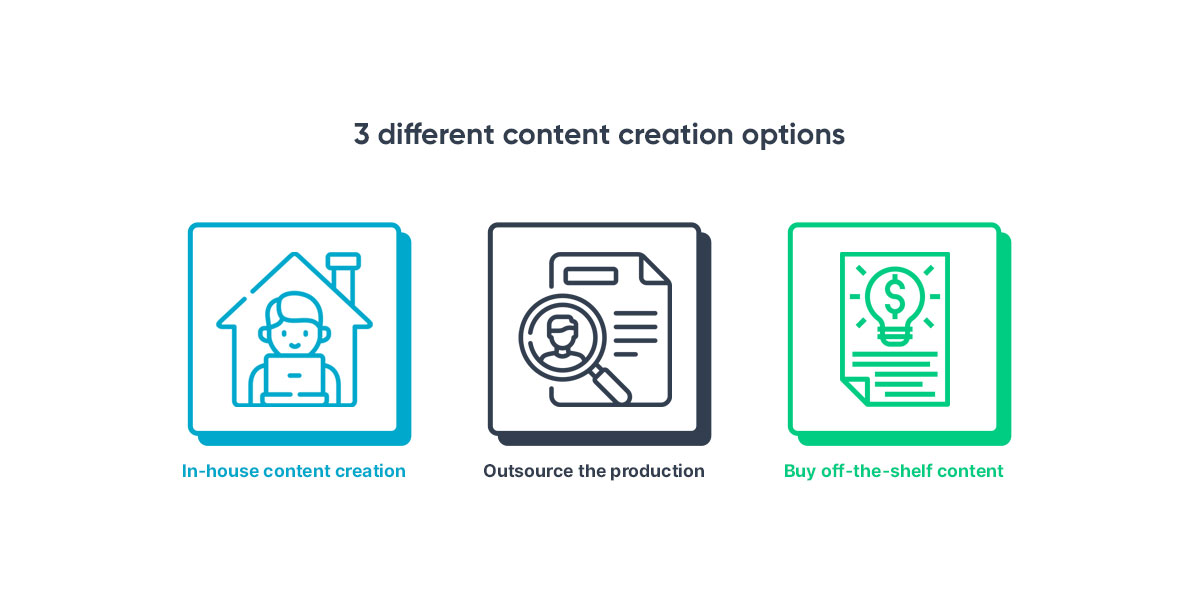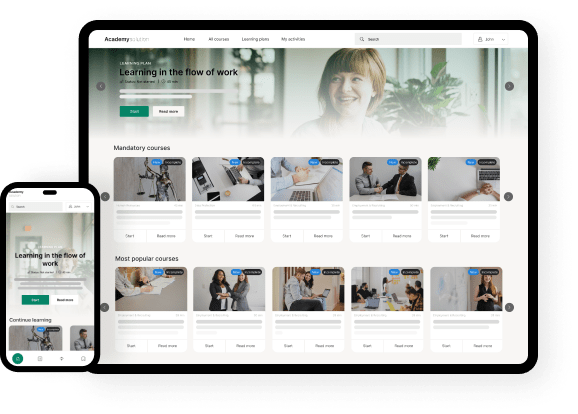If you want to start an e-learning business, there’s no getting around the content creation process. But what is the best approach to e-learning content creation anyway?
Deciding on a content creation process isn’t black and white. What works for one company might not work for another.
In this blog post, we go over the pros and cons of the most sworn content development options that exist. So, stick around to find a solution that fits you and your business requirements.

Creating content in-house
If you value proximity, keeping your content creation in-house might be the best solution for you.
Creating content internally is the obvious choice if you already have employees who are experienced content creators, or if you have the resources to hire professional creators or train existing employees in the art of content creation.
However, there are always two sides to a coin. Let’s dig into what can make in-house content creation a go or a no go for you and your company.
Pros
Creative control is yours
External content creators might have years of experience and vast knowledge of current trends. Yet, leaving creative decisions with someone outside your company isn’t always desirable.
No one knows your offering and organizational goals better than the people within your company. So, if you have the resources to keep content production in-house it is something worth leveraging.
Like people say: familiarity breeds creativity.
Making decisions in the context of a creative project isn’t as complicated as it might sound.
The more intuitive your e-learning platform is, the easier it is to customize your content and build personalized course catalogs.
At Cursum, we’ve built an easy-to-use e-learning platform on top of our powerful Learning Management System (LMS). Our e-learning platform, for example, has a responsive course builder and a multitude of add-on modules allowing for a more dynamic course building process.
Saves you money in the long run
Given you have enough human resources and the right authoring tools at your disposal, creating content in-house can save your company considerable money.
Of course, investing in authoring software and, if necessary, hiring additional experts for your in-house team can be an expense. But if you see it as a long-term investment, the benefits will most likely outweigh the costs.
Con
Slower turnaround time
When you choose to produce content internally, there are many aspects to cover.
If you have limited tools or restricted human resources available, this can be a major concern.
Forcing in-house content creators to juggle multiple projects at once can cause a slower turnaround time and will most likely also have an impact on the amount of content possible to produce. Potentially, this scenario will also influence the quality of your content.
Key considerations
Before establishing your in-house content creation team, it’s important to investigate whether or not this solution will bring your company lasting benefits.
So, ask yourself these questions before you invest in any authoring tools and hire or start training personnel for this task:
- Can we afford to build a dedicated team of content creators either from existing employees or new hires?
- Do we have the technical know-how to manage and structure courses?
- Will our production time and content quality be satisfying?
- Does our e-learning platform support our needs?
If you don’t align your expectations and look at your long-term goals, your internal content creation team might end up being merely a liability for your company.
Outsourcing e-learning content creation
A 2021 Training Industry Report indicated that in the area of custom content 34 % had been developed externally.
Based on the same report, large companies more than small or midsized (SMEs) expected a significant increase in outsourcing by 2022. SMEs are more likely to report that they don’t and won’t outsource.
With that, let’s look at the advantages and disadvantages of outsourcing your e-learning content creation process.
Pros
Additional expert insight
When you seek expert help, you most likely won’t have to go through a trial-and-error phase.
Experts are skilled in their area and will oftentimes have a few time-tested tricks up their sleeves.
This isn’t something you’d have access to if you keep the content creation process in-house. And if you’re new to the e-learning industry, this would especially come in handy.
Time-saving and quicker turnaround times
Working with a third-party content developer can be a great time-saver.
You will never have to allocate time to deal with troubleshooting. And having someone who deals with e-learning platforms every day also means that content updates can be implemented in a heartbeat.
All this brings about quick turnaround times.
In fact, you can opt for an outsourcing model that secures you never have to involve yourself in the process. The extent of your involvement depends on your collaboration agreement.
For example, some external creators let you opt for a 50/50 solution. It means you do 50 % of the work and they do the other 50 %. It could mean that you do the creative work while they focus on the technical aspects of the project.
Every e-learning business’ needs vary. And when outsourcing your content creation process, it’s important you find a model that suits your requirements.
Con
Possible project management issues
The quality of the project is only as good as how well you communicate with your external partners. Miscommunication and even disagreements can occur during the content creation process.
Sometimes, your varying ethos and styles can cause a great deal of project management issues, which can hamper the quality of the final product.
Content developers might charge you more than usual
When your content production requires more than the usual processes, the service charge is likely to go up. Content development might go beyond writing e-learning scripts and rapid prototyping and could, for example, include creating an Instructional Design Document (IDD) or audio files recording.
In these cases, the price can quickly add up.
So, if you require the service of an external creator for a longer period, it might be more economical for you to invest in your own in-house content creator.
Key considerations
To find out whether outsourcing your content creation process is the right choice for you or not, answering the following questions might help you decide:
- Are we willing to forego complete control over the project?
- Do we have the resources to initiate such a collaboration?
- How can we ensure the quality of our content without meeting with external content creators all the time?
Although outsourcing your e-learning content production isn’t uncommon, it can feel like a leap of faith. So, carefully examine your needs and research the market to find a partner that fits.
Buying off-the-shelf content
Finally, your third content creation option is to buy ready-to-sell content.
Off-the-shelf or ready-to-sell content is pre-designed learning courses sold in bundled packages or library subscriptions. It can either be standard or industry-specific content. Most off-the-shelf learning content come in the form of course catalogs ready to be uploaded to your e-learning platform.
Many choose ready-made content because of its accessibility and consistency. While buying ready-made content has some of the same benefits as hiring an external content creator, there are still a few things you may want to note before choosing this option.
Pros
Easy to implement
Pre-built e-learning content doesn’t need further customization. This makes it easier to deploy, which in turn means that the user will gain access to it much quicker.
If you need a wide selection of courses to roll out straight away, this is the perfect option for you.
Most ready-to-sell online learning content is SCORM-compliant and will be compatible with any LMS.
Our e-learning platform, for example, supports xAPI and SCORM packages which make for a smooth course deployment no matter how and where you’ve built your content.
Reduced development costs
Some of the top e-learning authoring tools in today’s market can cost up to $8,500. And according to Upwork, the hourly rate of an experienced instructional designer can range from $30 to $125 per hour.
When buying pre-packed content packages everything is included. Therefore, you don’t have to worry about extra and unforeseen costs that could possibly ruin your budget.
Cons
Lacks customization capabilities
When buying off-the-shelf content, it’s not always possible for you to customize the content. And if personal branding you value, this is something you really need to take into account.
You must also consider that the vendor might require the visibility of their branding.
However, depending on the pre-packed content vendor or creator, it might be possible to negotiate to implement your logo and colors.
Updating content can be an issue
Training needs and learning circumstances can change over time. Therefore, your content must be updated to match any changes.
Unfortunately, when buying pre-built content, you only pay a license to resell it. You’re usually not allowed to alter or change any of its parts.
Thus, when new knowledge comes along or your customers start demanding something different, you must wait for your vendor to either fix and update existing courses or produce new content.
Of course, another option would be to seek out another vendor that is more up to date with current learning trends and demands.
In this case, however, you need to consider any binding contract agreements with your current vendor. And you must also remember that the process of finding a new vendor might take time, which could possibly impact your customer relations.
Key considerations
Off-the-shelf courses have the most significant upside in terms of implementation and serviceability. But again, there are a few drawbacks to using ready-made content.
So, to get the best out of your decision, it’s good to ask:
- Do we have unique learning needs? If yes, would generic content address these needs?
- Do we want our content to reflect our brand?
- Do we have the budget to pay for custom content?
Again, content creation is something you deal with in the long run, so it pays off to weigh your options wisely.
Nonetheless, know that whatever type of e-learning content creation process you choose, Cursum offers the most powerful e-learning platform to help you host and distribute your content.
Schedule a free demo today and let us show you how our academy solution can do wonders for your expert business.


